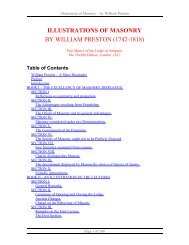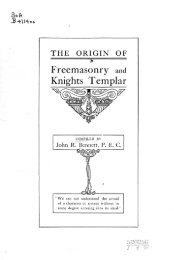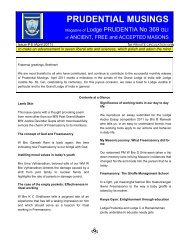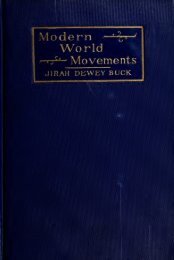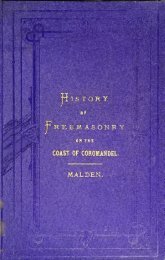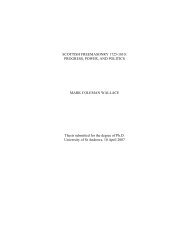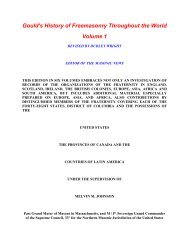Gould's History of Freemasonry Around the World - Lodge Prudentia
Gould's History of Freemasonry Around the World - Lodge Prudentia
Gould's History of Freemasonry Around the World - Lodge Prudentia
You also want an ePaper? Increase the reach of your titles
YUMPU automatically turns print PDFs into web optimized ePapers that Google loves.
28 FREEMASONRY IN THE DOMINIONhowever, <strong>the</strong> <strong>the</strong>ory <strong>of</strong> Lord Alexander's Initiation in Nova Scotia has nothingto support it . It is dismissed by most trustworthy writers as being mythical .It is unnecessary here to follow <strong>the</strong> fortunes <strong>of</strong> <strong>the</strong> settlement at Port Royalthrough <strong>the</strong> vicissitudes <strong>of</strong> <strong>the</strong> next hundred years . Never<strong>the</strong>less, it shouldbe recalled that <strong>the</strong> main events <strong>of</strong> <strong>the</strong> century were <strong>the</strong> capture <strong>of</strong> <strong>the</strong> fortressby Colonel Sedgewick, in 1654 ; its cession to France by <strong>the</strong> Treaty <strong>of</strong> Breda, in1667 ; its capture by Sir William Phips in 169o ; <strong>the</strong> various o<strong>the</strong>r sieges <strong>of</strong> itfrom time to time, both before and after its capture by Colonel Nicholson in171o, at which time it was renamed Annapolis Royal ; and its cession to Britainby France according to <strong>the</strong> terms <strong>of</strong> <strong>the</strong> Peace <strong>of</strong> Utrecht in 1713 .Although it is unlikely that <strong>Freemasonry</strong> existed among <strong>the</strong> French orEnglish settlers in <strong>the</strong> Colony during this early period, <strong>the</strong>re are some whoargue that it did . There is in <strong>the</strong> library <strong>of</strong> <strong>the</strong> Grand <strong>Lodge</strong> <strong>of</strong> Massachusettsa work entitled Ahiman ReZon : A Concise <strong>of</strong> Account <strong>of</strong> <strong>the</strong> Rise and Progress<strong>of</strong> <strong>Freemasonry</strong> in <strong>the</strong> Province <strong>of</strong> Nova Scotia from <strong>the</strong> First Settlement <strong>of</strong> It to ThisPresent Time-1786, in which <strong>the</strong> following statement is made : "From Europe<strong>the</strong> Royal Art crossed <strong>the</strong> Atlantic with <strong>the</strong> first emigrants and settledin various parts <strong>of</strong> America . It is said to have been known in Nova Scotia whilethat region was in <strong>the</strong> hands <strong>of</strong> <strong>the</strong> French . This statement could not have beenbased upon knowledge <strong>of</strong> <strong>the</strong> " Masonic Stone " <strong>of</strong> 16o6, or upon <strong>the</strong> <strong>the</strong>oryregarding Lord Alexander's Initiation, however, for <strong>the</strong> " Masonic Stone "was not discovered until 1827, and <strong>the</strong> evidence <strong>of</strong> Alexander's membershipwas not made public until long after 1786, <strong>the</strong> year in which <strong>the</strong> statement waspublished . In fact, research has so far failed to corroborate <strong>the</strong> statement that<strong>Freemasonry</strong> was known among <strong>the</strong> French settlers . It is not impossible, however,that generations may discover and bring to light evidence to support<strong>the</strong> supposition <strong>of</strong> <strong>the</strong> author <strong>of</strong> Ahiman Rezon .In this same work, it is also stated that " it is certain that as soon as <strong>the</strong>English took possession ' <strong>of</strong> <strong>the</strong> Colony ' <strong>the</strong>y took care to encourage thischaritable institution (<strong>Freemasonry</strong>) ." Just what " certain " evidence insupport <strong>of</strong> this statement existed in 1786 is not known, but <strong>the</strong>re is a sort <strong>of</strong>corroboration in a statement <strong>of</strong> M .- . W . • . Bro . Major-General J. Wimburn Laurie,Grand Master <strong>of</strong> Nova Scotia. In his address to <strong>the</strong> Grand <strong>Lodge</strong> <strong>of</strong> NovaScotia in 1884, Bro . Laurie referred to <strong>the</strong> receipt <strong>of</strong> a photographic copy <strong>of</strong><strong>the</strong> Ledger <strong>of</strong> St . John's <strong>Lodge</strong>, at Philadelphia, dated 1731, which had beensent to him as evidence that <strong>the</strong> <strong>Lodge</strong> at Philadelphia was <strong>the</strong> first Masonic<strong>Lodge</strong> to be organised in America during <strong>the</strong> Colonial period . But we knowthat Bro . Laurie was not completely convinced by <strong>the</strong> evidence, for in <strong>the</strong> sameaddress he went on to say that " from circumstances that have come to myknowledge, I believe it to be quite within <strong>the</strong> bounds <strong>of</strong> possibility that evidencewill in due time be forthcoming that a Masonic <strong>Lodge</strong> regularly metand transacted Masonic business at a much earlier date than 1731 in our ownProvince . I have been for some time promised <strong>the</strong> documents by a gentlemanwho is not a member <strong>of</strong> <strong>the</strong> Craft, and I trust his disinterested efforts to obtain



